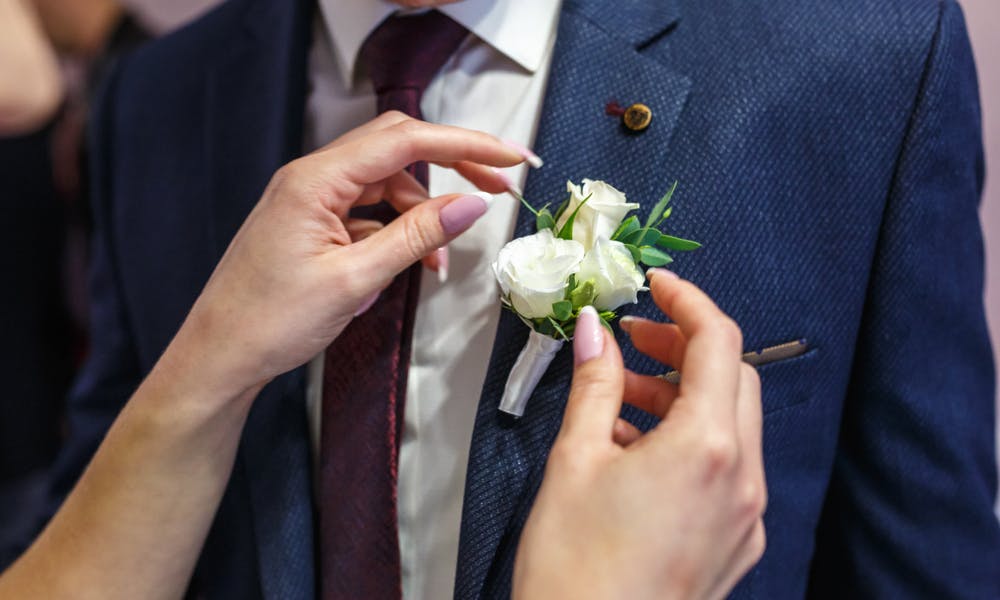Because boutonnieres are reserved for special occasions such as weddings or fancy parties, and you don’t pin buttonholes every day, it might be difficult to pick up this skill. In this article, we examine which situation is ideal for a boutonniere and how to pin it simple and easy, either on the lapel of the coat or on a shirt, or even by fastening it in a buttonhole. We discuss:
* Who should wear a boutonniere?
* How to wear a boutonniere
* How to pin a boutonniere
Who Should Wear a Boutonniere?
One of the primary events in which people wear boutonnieres is a wedding. They are customarily paid for by the family who finances the entire event, usually the bride’s family. There are also weddings in which the groom’s family finances the wedding; thus, they have an obligation to purchase boutonnieres for the bride, groom, and other special people at the wedding.
Typically, the bride, bridesmaids, parents and close relatives wear boutonnieres, and some of the attendees wear boutonnieres to establish their position as a close relative, such as the groom’s grandfather.
The bridesmaids aided by the mothers of the grooms are destined to pin on the boutonnieres. At other formal parties, it is said that the girl must pin on the boutonniere on her partner.
The flowers commonly used for boutonniere are those with thick stems that last longer without water, such as carnations, calla lilies, and roses. However, you can be creative, if you are not intimidated by the fragility of some extraordinary beautiful flowers, such as daisies, and orchids.
There are no strict rules regarding the occasions when you should wear a boutonniere. They can be worn on any special occasion, but if you wear them for an interview in order to get a job or at a funeral, then a boutonniere might not be the best accessory you could choose.
A boutonniere is a real flower worn on the lapel of a man’s suit jacket or coat. Theoretically, it can be any flower that the man likes, but the most common are carnations and roses. Men wore boutonnieres for decades, and, in the interwar period, boutonnieres were much more common than they are now. These add a distinctive hue to the elegance of a man’s coat.
As for the color, it should be matched with a tie, handkerchief, or anything else in the outfit that you think is appropriate. It is known that many times a boutonniere can replace the pocket square. You can wear both a boutonniere and a pocket square, but, in this case, you have to be careful to use either a boutonniere or square in a paler color, so you don’t have too much color on your jacket.
If we refer to wedding boutonnieres, they are different depending on what role you play in that wedding. The groom, groomsmen, bridesmaids, the parents of the bride and groom wear a special boutonniere. Guests should not wear boutonnieres, but if they buck tradition and do it anyway, these should be different from those who are the main actors of the marriage, such as are the bride, the groom, their parents or godparents.
The colors of the boutonnieres must be according to the season in which the wedding takes place. For autumn weddings, the flowers for boutonnieres should be in earth colors. The most usual flowers used are roses, calla lilies, or other dark red or orange flowers.
At winter weddings, the colors are dark or metallic, as such boutonnieres are made using especially red carnations, roses, tulips, or gardenias.
Spring weddings inspire freshness, so you want to forget about the dark and intense colors. The most suitable flowers for this season seem to be lilacs and hydrangeas.
For summer weddings, when there is a lot of heat and sun, very suitable for your boutiques are poppy flowers, chrysanthemums or even sunflowers.
If you go to an opera, ballet or theater performance, these are formal occasions, excellent for wearing boutonnieres. It is best to wear carnations or roses on lapels of black suits. The white color is most suitable for the day, and the red color is very suitable to be worn in the evening.
The flowers for boutonnieres can be natural or made from silk. The natural flowers give a special elegance to the wearer, but they can fade away relatively quickly. Silk flowers are forever, can be ordered online easily, are easy to attach on the back, but they are not so elegant, and are more expensive.
How to Pin a Boutonniere
When you have decided to wear a boutonniere, there are some rules that you must follow for pin-up on your lapel or on your shirt.
*Lapel method. The flower has to be put on the left lapel, and the bloom has to be above the buttonhole. You should not see any leaf or green part of the flower. Also, you have to push your pin through the back part of the lapel, on the diagonal, to the front of the coat lapel. Then push the pin back from front to back, passing through the thickest part of the flower stem. Check if the flower is securely fastened.
*Shirt method. The traditional location of the boutonniere is on the upper left side of the shirt, above the heart, or if the shirt has a pocket on this side, at the top of the pocket. The pin is easily inserted into the boutonniere and is fixed from right to left. The pin must enter the fabric and then exit the fabric, leaving a small pocket for the flower stem. Strain the stem of the flower through this small pocket and then flatten the fabric and check the boutonniere.
